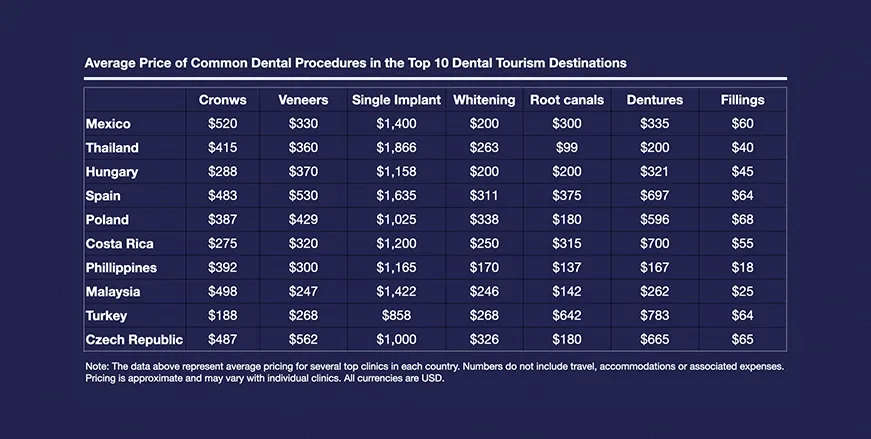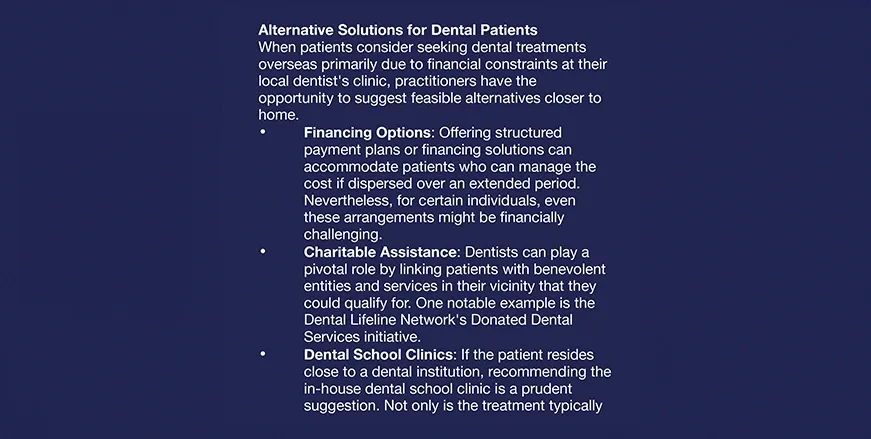Exploring Dental Travel in Response to Rising Healthcare Expenses

Introduction
As healthcare expenses continue to climb, many individuals, especially those in America and Canada, are struggling with tough choices about their health management. To cut costs, some are even skipping routine preventive treatments. Dental care is one such area where this is evident, which can unfortunately lead to more severe and expensive emergency treatments in the future.
In response to these challenges, a growing number of Americans and Canadians are exploring dental tourism as a cost-saving measure. This trend of seeking medical or dental care in foreign lands isn't new—it's been a part of our history for ages. Today, its popularity has surged, giving rise to a whole industry that links patients with affordable care options overseas. Yet, as appealing as it sounds, there are vital questions every prospective dental tourist should consider: Does the monetary savings justify the potential risks of getting dental work done abroad? How can they identify reputable dental professionals in a foreign country? Moreover, how can local dentists advise those contemplating this option, ensuring patient safety and satisfactory outcomes?
The Appeal of Overseas Treatment
People are drawn to dental tourism for various reasons. The Centers for Disease Control and Prevention (CDC) notes that some are immigrants looking to return to their native countries for treatments. Others might be seeking procedures not available in their home countries. But for many, the primary allure is the significant cost reduction. The CDC highlights that dental care, cosmetic/plastic surgery, and heart surgery are the top treatments sought overseas.
So, what kind of savings are we talking about? Research from Patients Beyond Borders, a firm specializing in international medical procedures, lists the leading destinations for U.S. dental tourists as Mexico, Thailand, Hungary, Spain, Poland, Costa Rica, the Philippines, Malaysia, Turkey, and the Czech Republic. In terms of savings: dental work in Mexico can cost 40%–65% less than in the U.S., while in Costa Rica, patients might save between 45%–65%. Thailand offers savings ranging from 50% to 75%. These percentages give a clear picture of the potential savings across various dental procedures in these top dental tourism destinations.
In summary, while dental tourism offers an attractive alternative to the high costs of domestic care, it's essential for patients to research and understand the pros and cons. Considering the potential health risks, ensuring quality, and understanding the logistics of post-treatment care are crucial factors in making an informed decision
 Why do countries like Mexico offer such substantial savings on dental procedures? The answer lies in several key factors. First and foremost, the living expenses in Mexico are considerably lower than in the U.S. or Canada. This economic difference allows local dentists to run their practices more affordably. Notably, Mexican dentists aren't mandated to invest in malpractice insurance, further reducing their operational costs. Furthermore, the financial burden of education is lessened by government aids, which graduates offset by providing a year of free service post-graduation.
Why do countries like Mexico offer such substantial savings on dental procedures? The answer lies in several key factors. First and foremost, the living expenses in Mexico are considerably lower than in the U.S. or Canada. This economic difference allows local dentists to run their practices more affordably. Notably, Mexican dentists aren't mandated to invest in malpractice insurance, further reducing their operational costs. Furthermore, the financial burden of education is lessened by government aids, which graduates offset by providing a year of free service post-graduation.
Dental tourism doesn’t just stop at the clinic's door. Many patients intertwine their dental care with leisure, resulting in a therapeutic holiday. There's a growing number of testimonials, like that of a Washington Post journalist who shared his cost-effective journey of getting crowns in Costa Rica. He mentioned, “In the days it took to craft the crowns, my wife and I explored the mesmerizing Drake Bay area, indulging in snorkeling and observing mangroves.” The entire escapade, inclusive of travel, stay, sustenance, and dental procedure, culminated in a sum of $4,000. This was a neat saving of $1,000 compared to just the dental costs he would've incurred stateside.
Particularly, for those residing near the U.S.-Mexico border or those amenable to drive, the savings can be further accentuated. A prime destination for such individuals is the quaint town of Los Algodones.
Diving into the ‘Molar City’ Phenomenon
Tucked away near the Colorado River and a mere 30-minute jaunt from Yuma, Arizona, Los Algodones has rightfully earned its moniker, “Molar City.” With a modest resident population of 5,000, this town witnesses an influx of thousands annually, all attracted to its impressive density of approximately 350 dental clinics. Some of these clinics go the extra mile by facilitating patient transportation from distant hubs.
A salient feature of Los Algodones' economy is its strong pivot towards dental tourism. The town's plethora of dental establishments benefit from the accessibility to local dental labs, ensuring quick and cost-efficient services. On average, dental services are priced at a third of U.S. rates, with many patients attesting to even greater discounts.
However, it's not all rosy. While a significant number recount positive experiences, there are tales of substandard procedures too. Dr. Craig Barrows, a dentist based in Yuma, has witnessed a spectrum of outcomes. With Yuma housing around 90,000 tourists during winters, many of whom capitalize on its closeness to Los Algodones, Dr. Barrows has had patients requiring corrective treatments. He recalls a particularly distressing case of a patient who underwent a $25,000 implant procedure in Los Algodones, only to face infections and no guarantees on the implants, thus nullifying the expected savings.
In conclusion, while dental tourism, especially in places like Los Algodones, offers appealing financial advantages, it's imperative for individuals to conduct comprehensive research, ensuring they receive quality care and genuine savings.
The Surge of Dental Tourism and Its Implications
In the past decade, dental tourism has seen a significant surge in its acceptance and popularity. This growing trend has paved the way for companies like Patients Beyond Borders and Dental Departures to take center stage, assisting potential medical tourists in planning their trips. These companies serve as bridges, connecting patients to international healthcare providers through strategic marketing initiatives. As per their website, Patients Beyond Borders positions itself as a comprehensive resource for both patients and healthcare professionals. Its Founder and CEO, Josef Woodman, emphasizes his over 10-year commitment to “scouring the globe for top-notch, affordable medical care options,” encompassing dental care. For those considering this venture, consulting firms like Patients Beyond Borders can be invaluable. They employ stringent criteria for vetting healthcare establishments, ensuring:
- Accreditation by a universally acknowledged body.
- A clean legal record.
- An accessible English website.
- Transparent listing of prominent physicians.
- Clearly stated services available for patients.
Another pivotal component in this equation is insurance. Companies such as GeoBlue (affiliated with Blue Cross Blue Shield), Aetna, and Cigna have tailored insurance plans that cater to individuals venturing outside the U.S. for medical or dental care. This strategic move benefits insurers, as it often costs them considerably less than domestic procedures. Some progressive employers even shoulder the entire cost of medical tourism ventures for their workforce. Dr. Barrows, previously mentioned, shared an insight into the insurance landscape from a personal angle. His wife, a public school educator, is covered under an insurance policy that clearly acknowledges its validity in Mexico, a feature shared with several other public sector employees in Yuma. But it's not devoid of its challenges. Dr. Barrows recollected an incident with a patient who, after having her amalgam fillings in Mexico replaced with composite, later approached him for pain relief. Dr. Barrows replaced all her fillings, but insurance complications arose. The initial, cheaper Mexican procedure was already accounted for by her insurance, causing her subsequent claim for Dr. Barrows’ services to be denied. This left her shouldering the financial burden out-of-pocket. To sum up, while the rising prominence of dental tourism provides a viable alternative for many, it's essential to understand the intricate dynamics of insurance and quality assurance when making such decisions.
The European Landscape of Dental Tourism
Dental tourism isn't just a North American phenomenon; it's also gaining traction in Europe. Many Europeans are journeying to countries within the continent for affordable dental care. For instance, many Britons opt for dental services in Hungary, Slovakia, and Poland due to competitive pricing, while the Irish are attracted to India, the UAE, Malta, and Turkey.
To attract dental tourists, countries like Poland and Croatia have invested heavily in public relations, highlighting their medical tourism capabilities. The investment seems to be paying off as Europe witnesses an annual growth of 12%–15% in medical tourism.
Interestingly, U.S. citizens can tap into the European dental market with relative ease. The Schengen Agreement allows those with valid U.S. passports to traverse any nation within the Schengen Zone for up to 90 days without needing a visa. Notably, three of the top dental tourism destinations—Hungary, Spain, and the Czech Republic—are part of this zone. So, while accessing dental care, American tourists can also indulge in European sightseeing.
To streamline the dental care experience within Europe, numerous entities are striving to standardize dental education and care quality across EU member states. This ensures ease of mobility for healthcare practitioners within the region. Organizations like the Association for Dental Education in Europe emphasize educational standardization, while the Federation of European Dental Competent Authorities and Regulators focuses on the clinical aspect. Such endeavors enhance the overall quality and uniformity of care, although U.S. patients might still encounter slight variations in regional care practices.
In essence, Europe offers a vibrant and evolving landscape for dental tourism, driven by affordability, ease of access, and a push towards standardized care quality.
Guidance on Dental Tourism for Practitioners and Patients
Dental professionals may occasionally interact with patients keen on exploring dental tourism. Instead of outright opposing the idea, practitioners should underscore the essence of comprehensive research.
The CDC emphasizes that anyone eyeing healthcare beyond the U.S. borders must deeply delve into aspects like medicines, infection control practices, and potential risks of antibiotic-resistant bacteria. It's also crucial to comprehend the benchmarks set for accreditation by global entities such as Joint Commission International, DNV GL International Accreditation for Hospitals, and the International Society for Quality in Healthcare. Moreover, being informed about recourse in case of unsatisfactory treatment outcomes, handling post-treatment complications, or pursuing refunds is essential. Every nation might have diverse grievance redressal mechanisms, be it through health ministries or specific complaint forums.
Patients must discern between facts and promotional content. For instance, some dentists abroad might highlight their U.S. training, which could merely be a short course, possibly misleading patients into assuming they earned their dental degrees from American institutions. Before making a decision, obtaining detailed profiles of prospective dental care providers to assess their qualifications and experience can be invaluable. Given the unfamiliarity with foreign educational setups, patients should recognize the standard-setting bodies in those nations to ensure equivalent care quality.
Dental professionals might also suggest liaising with consultation agencies like Patients Beyond Borders that pre-evaluate service providers. Patients should also consider whether a dentist is affiliated with globally recognized dental associations. For cosmetic dental procedures, affiliations with bodies like the International Federation of Esthetic Dentistry or the European Academy of Esthetic Dentistry can be indicators of quality. Several U.S. organizations, such as the American Academy of Esthetic Dentistry and the American Academy of Cosmetic Dentistry, also extend membership to overseas professionals.
 When a patient contemplates dental tourism, it presents a golden chance for U.S. and Canadian dental practitioners to position themselves as trusted advisors in oral health. While many may not advocate for overseas dental treatments due to potential revenue loss and feelings of being undervalued, some patients might find the option unavoidable. By providing informed counsel, emphasizing the significance of preparatory research, and actively seeking treatment records post-visit, dental professionals can fortify their relationship with the patient.
When a patient contemplates dental tourism, it presents a golden chance for U.S. and Canadian dental practitioners to position themselves as trusted advisors in oral health. While many may not advocate for overseas dental treatments due to potential revenue loss and feelings of being undervalued, some patients might find the option unavoidable. By providing informed counsel, emphasizing the significance of preparatory research, and actively seeking treatment records post-visit, dental professionals can fortify their relationship with the patient.
References
“Medical Tourism.” Centers for Disease Control and Prevention, 5 Dec. 2016, www.cdc.gov/features/medicaltourism/index.html. Accessed 13 Nov. 2019. Healthy Travel Media. Patients Beyond Borders, www.patientsbeyondborders.com. Accessed 13 Nov. 2019. Robbins, Ted. “A Reason To Smile: Mexican Town Is A Destination For Dental Tourism.” NPR, 9 June 2014, www.npr.org/sections/health-shots/2014/06/09/318212444/a-reason-to-smile-mexican-town-is-a-destination-for-dental-tourism. Accessed 13 Nov. 2019. Salmon, Mike. “Dental Tourism — Bargain Dentistry and a Vacation to Boot.” The Washington Post, 1 Sept. 2019, www.washingtonpost.com/health/dental-tourism--bargain-dentistry-and-a-vacation-to-boot/2019/08/30/4fd4a466-aef0-11e9-a0c9-6d2d7818f3da_story.html. Accessed 19 Nov. 2019. Dayo Global Medical Network LLC. Dayo Dental, www.dayodental.com. Accessed 13 Nov. 2019. Worldwide Insurance Services LLC. “GeoBlue: Travel Medical & International Health Insurance.” GeoBlue, www.geobluetravelinsurance.com. Accessed 19 Nov. 2019. “International Health Insurance.” Aetna International, www.aetnainternational.com/en/individuals.html. Accessed 17 Nov. 2019. “Cigna International Health Insurance.” Cigna, www.cigna.com/international/. Accessed 17 Nov. 2019. Orenstein, Beth. “Medical Tourism Might Be Just the Ticket.” Insure.com, www.insure.com/health-insurance/medical-tourism.html. Accessed 17 Nov. 2019. Telegraph Financial Solutions. “Paying for Dental Treatment Abroad.” The Telegraph, 18 Oct. 2019, www.telegraph.co.uk/financial-services/currency-exchange/international-money-transfers/paying-dental-work-abroad/. Accessed 19 Nov. 2019. Quinlan, Áilin. “Air Smiles: Is Economy-Class Dental Tourism Worth the Risk?” Irish Examiner, 10 April 2018, www.irishexaminer.com/breakingnews/lifestyle/healthandlife/air-smiles-is-economy-class-dental-tourism-worth-the-risk-861150.html. Accessed 19 Nov. 2019. Bradbury, Paul. “Lessons From Poland: How to Develop Medical Tourism in Central Europe.” Total Croatia News, 23 Oct. 2019, www.total-croatia-news.com/business/39200-lessons-from-poland. Accessed 19 Nov. 2019. Wasik, Zosia. “Medical Tourism on the Rise in Central and Eastern Europe.” Financial Times, 19 Oct. 2017, www.ft.com/content/24d0e36c-72eb-11e7-93ff-99f383b09ff9. Accessed 19 Nov. 2019. U.S. Department of State — Bureau of Consular Affairs. “U.S. Travelers in Europe.” Travel.State.Gov, updated 6 Nov. 2019, www.travel.state.gov/content/travel/en/international-travel/before-you-go/travelers-with-special-considerations/schengen.html. Accessed 20 Nov. 2019. “Schengen Area — The World’s Largest Visa Free Zone.” Schengen Visa Info, updated 1 Oct. 2019, www.schengenvisainfo.com/schengen-visa-countries-list/. Accessed 20 Nov. 2019. Allen, W.R. “Dental Education in the European Union.” British Dental Journal, vol. 188, supplement, Sept. 2005, pp. 33-34. Association for Dental Education in Europe. “About the ADEE.” ADEE, www.adee.org/about/index.html. Accessed 20 Nov. 2019. Federation of European Dental Competent Authorities and Regulators. “What is FEDCAR?” FEDCAR, www.fedcar.eu/en/. Accessed 20 Nov. 2019. “About AAED.” American Academy of Esthetic Dentistry, www.estheticacademy.org/page/AboutAAED. Accessed 19 Nov. 2019. “Membership.” American Academy of Cosmetic Dentistry, www.aacd.com/membership. Accessed 19 Nov. 2019.

